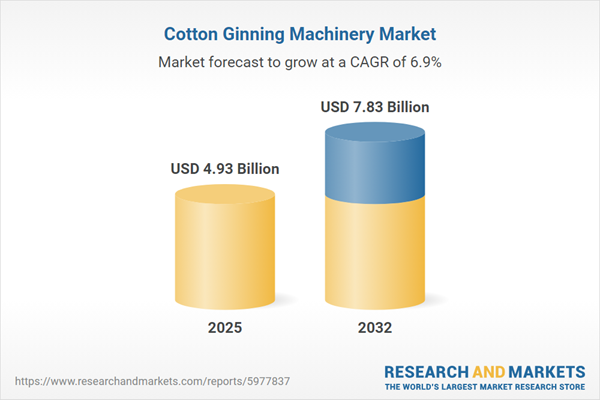Speak directly to the analyst to clarify any post sales queries you may have.
Senior executives overseeing procurement and investment in the cotton ginning machinery sector face an industry characterized by rapid modernization, regulatory changes, and shifting operational priorities. As transformation accelerates, leaders must harness up-to-date intelligence to drive strategic decision-making and deliver resilient business value in global markets.
Market Snapshot: Cotton Ginning Machinery Market Size and Industry Dynamics
The cotton ginning machinery market is projected to grow from USD 4.61 billion in 2024 to USD 4.93 billion in 2025, representing a CAGR of 6.85%. This expansion reflects the ongoing adoption of advanced technology platforms, upgraded machinery, and a stronger focus on environmental, social, and governance compliance. Evolving industry regulations are compelling supply chain participants to prioritize innovation, redefine business processes, and optimize investments in digital capability. Automation trends and data-centric management practices are increasingly shaping competitive strategy and supporting global market resilience for suppliers and buyers alike.
Cotton Ginning Machinery Market: Scope & Segmentation
This report delivers essential segmentation and strategic insights tailored to senior leaders responsible for procurement and strategic investments in the cotton ginning machinery market. Segmentation analysis enables alignment of technology solutions with organizational and regional requirements. Key focus areas include:
- Ginning Equipment Types: Eccentric, roller, and saw machines offer flexibility for different fiber characteristics and adapt to unique production demands across environments.
- Output Capacity Ranges: Options range from large-scale processors to compact, specialized units, enabling organizations to address operational throughput goals efficiently.
- Automation Levels: Solutions include fully automatic, semi-automatic, and manual systems, allowing leaders to balance labor optimization with process efficiency.
- Power Ratings: Diesel, electric, and gas-powered machinery maximize compatibility with diverse infrastructure contexts and sustainability priorities.
- Key Components: Pre-cleaners, dust collectors, baling units, and modular modules help companies improve operational safety and increase productivity longevity.
- End Users: Cotton growers, service organizations, and textile producers each benefit from tailored machinery that boosts equipment performance and lifecycle.
- Distribution Channels: Direct procurement from manufacturers and aftermarket solutions secure consistent access to replacement parts, technical support, and ongoing workforce training.
- Regional Markets: In-depth coverage of North America, South America, EMEA, and Asia-Pacific, with analysis emphasizing regional investment trends, technology adoption, and regulatory dynamics.
- Industry Innovators: Influential market participants such as Lummus Corporation, Bühler AG, Lakshmi Machine Works Limited, Continental Eagle Manufacturing Company, and Bajaj Steel Industries Ltd. offer extensive lifecycle support and set quality benchmarks globally.
Key Takeaways for Senior Decision-Makers
- Sensor-driven automation promotes process reliability, supports consistent output quality, and enhances efficiency for both bulk and specialty operations.
- Electric and hybrid-powered equipment supports emerging sustainability standards and helps organizations comply with evolving regulatory expectations, futureproofing investments in core assets.
- Modular system design increases flexibility, allowing rapid upgrades and smooth adaptation to evolving operational requirements without significant disruption.
- Collaboration with established manufacturers ensures reliable technical support, minimizes risk, and aids compliance during periods of regulatory or market transition.
- Advanced dust management and debris handling solutions improve workplace safety, support regulatory alignment, and drive cost savings via reduced equipment maintenance needs.
- Implementation strategies tailored by region unlock operational synergies, align resource allocation with workforce capabilities, and help navigate unique governance landscapes.
Tariff Impact: Navigating Regulatory Changes in the US Market
With new US tariffs on cotton ginning machinery planned for 2025, suppliers are increasing regional assembly and deepening domestic supply chain relationships. These adjustments prompt organizations to reassess sourcing and manufacturing strategies, strengthening resilience in the face of new trade requirements. Proactive procurement and agile planning remain critical in managing budget exposure and supply continuity as regulatory conditions evolve.
Methodology & Data Sources
Insights provided in this report are derived from direct interviews with senior executives at major cotton producers and equipment manufacturers. Supplementary independent audits and detailed analysis of technical and regulatory documents further validate findings, ensuring robust support for executive-level decisions.
Why This Report Matters for Senior Leadership
- Segmented analysis equips procurement teams to select machinery aligning with strategic and operational goals across global and regional markets.
- Timely intelligence on regulatory trends and technology adoption optimizes capital planning and risk controls for leadership teams.
- Expert perspectives prepare senior management to anticipate market transitions and deploy effective strategies for sustained performance.
Conclusion
This report helps senior decision-makers optimize investments, accelerate modernization, and build organizational resilience as the cotton ginning machinery market continues to evolve.
Additional Product Information:
- Purchase of this report includes 1 year online access with quarterly updates.
- This report can be updated on request. Please contact our Customer Experience team using the Ask a Question widget on our website.
Table of Contents
3. Executive Summary
4. Market Overview
7. Cumulative Impact of Artificial Intelligence 2025
Companies Mentioned
The companies profiled in this Cotton Ginning Machinery market report include:- Lummus Corporation
- Bühler AG
- Lakshmi Machine Works Limited
- A. G. Machinery India Private Limited
- Continental Eagle Manufacturing Company
- Deligent Ginning Machinery Pvt. Ltd.
- Ginning Solutions, Inc.
- Bajaj Steel Industries Ltd.
Table Information
| Report Attribute | Details |
|---|---|
| No. of Pages | 193 |
| Published | October 2025 |
| Forecast Period | 2025 - 2032 |
| Estimated Market Value ( USD | $ 4.93 Billion |
| Forecasted Market Value ( USD | $ 7.83 Billion |
| Compound Annual Growth Rate | 6.8% |
| Regions Covered | Global |
| No. of Companies Mentioned | 9 |









